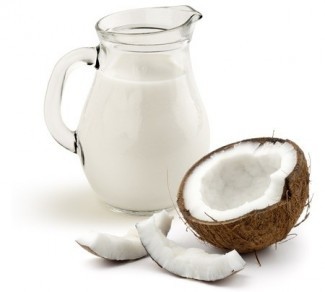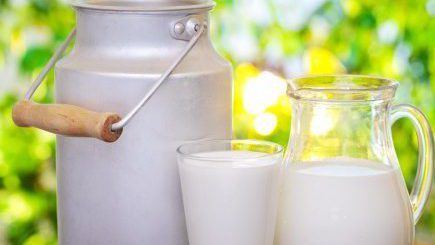Aside from wheat and gluten sensitivities, there most likely isn’t a more debatable issue in the food industry today than dairy and lactose intolerance.
Reality is: the basic facts are tough to find in the thick of the “milk war,†and no surprise millions of men and women are bewildered.
We’re caught in the center of a huge marketing and advertising barrage from both camps.
•   Milk is good: “Milk does a body good.â€
•   Milk is bad: “People are the only species that drinks another animal’s milk.â€
•   Milk is good: “Got milk?†(included, of course, is a stunning celebrity with a milk mustache).
•   Milk is bad: “What’s in YOUR milk?†(included, of course, is a list of dangerous chemicals which are connected to just about every thing from cancer to Alzheimer’s disease).
And the list goes on and on.
After sifting through the mumbo-jumbo, it becomes very obvious this isn’t a black-and-white subject, and suggesting that “milk is bad†or “milk is good†plainly leaves much to be desired.
Is Milk Healthy?
The answer to this question is the all-nebulous, “It depends.â€
•   It will depend on whether or not the milk was homogenized.
•   It will depend on whether or not the milk was pasteurized.
•   It will depend on whether or not the milk was fortified.
•   It will depend on whether or not the milk was taken from a hormone-injected animal.
•   It will depend on whether or not the milk was taken from a grass fed animal.
•   It even will depend on whether or not the milk was taken out of a cow, goat or sheep.
Like many things at the grocery stores these days, the more natural it is (that is, the less involved people are in producing it) the more ideal it is for human consumption.
It is crucial to recognize that we have documented accounts of humans ingesting animal milk for literally thousands of years. The distinction between the milk in our refrigerators now and what our ancestors and forefathers drank, however, is infinitely important.
Fresh milk from cows, goats and sheep is a Superfood in the sense that it is exceptionally nutrient dense if it is not meddled with. It is loaded with vitamins, minerals, and naturally-occurring enzymes that has traditionally made lactose intolerance almost unheard of until we began toying with the cows and their milk in the 20th century.
The main point here is that raw milk from grass-fed animals, not puffed up with GMO feed and injected with hormones, is completely healthy and should be enjoyed on a day to day basis.
What About Lactose Intolerance?
 Lactose is a milk sugar, and if somebody doesn’t naturally have a large amount of lactase, they will inevitably suffer significantly when they have dairy products. Typical signs or symptoms include:
Lactose is a milk sugar, and if somebody doesn’t naturally have a large amount of lactase, they will inevitably suffer significantly when they have dairy products. Typical signs or symptoms include:
•   Bloating
•   Constipation
•   Cramps
•   Diarrhea
•   Gas
•   Nausea
•   Pain
•   And even vomiting
The typical medical explanation is that:
Lactase activity is high and vital during infancy, but in most mammals, including most humans, lactase activity declines after the weaning phase. In other healthy humans, lactase activity persists at a high level throughout adult life, enabling them to digest lactose as adults. This dominantly inherited genetic trait is known as lactase persistence. (1)
Nevertheless, this theory does not take into account thousands of years of regular use without commonplace reference to lactose intolerance signs or symptoms all through recorded history. Obviously, it is undeniably a possibility for people to have struggled with milk-related sensitivities and allergies through antiquity, but it’s far from probable that people would have went on drinking milk if as many as are afflicted now suffered back then. And the frequency of lactose intolerance these days is positively alarming!
According to the University of Georgia, “On average, 80% of Asian and Native Americans are lactose intolerant, 75% of African Americans, 51% of Hispanic Americans and 21% of Caucasian Americans.†(2)
In essence, this begs the question, “Why are so many people lactose intolerant today?â€
The key to figuring out the lactose problem is to recognize that the milk being commonly sold today is prepared in such a way that the enzyme lactase cannot do its work to break down lactose as it was meant to. As stated by Organic Pastures founder Mark McAfee, the key is to drink raw milk:
“The experts I have spoken with deny the presence of lactase in raw milk; however, it is the friendly bacteria in raw milk that facilitate the creation of lactase in the intestine where it is needed. That is why lactose-intolerant people can drink raw milk without a problem. Pasteurization kills these friendly bacteria.” (3)
This knowledge has been backed by the scientific literature since 1984. A landmark study putting this issue to bed was revealed in the American Journal of Clinical Nutrition, which explored the reason why fermented milk (yogurt) has commonly been well tolerated by lactase-deficient people and, particularly, why lactose from yogurt is easily digested in comparison to that from regular milk. (4)
Evaluating the effects of three fermented, microbial-rich dairy foods – pasteurized yogurt, butter milk (cultured milk), sweet acidophilus milk – the scientists found that:
“The studies demonstrated that yogurt is unique among the products tested in enhancing the digestion of lactose. Furthermore, pasteurization of yogurt eliminated the enhanced digestion of lactose, reduced the inherent lactase activity of the yogurt by 10-fold and reduced cell counts by 100-fold. Interestingly, eight of nine subjects fed cultured milk experienced gastrointestinal distress, whereas all subjects fed pasteurized yogurt were symptom free, even though the amount of malabsorbed lactose was similar.” (4)
Regardless of some sources that assert that fermented milk like kefir is the key element to solving lactose intolerance (regardless if it is pasteurized or not) the final results from this study plainly show that pasteurization is the key to lactose intolerance, not fermentation.
A1 Casein Allergies
 There’s yet another rumor out there that so-called A1 casein allergies are a major contributor to dairy sensitivities.
There’s yet another rumor out there that so-called A1 casein allergies are a major contributor to dairy sensitivities.
Usually, in their next breath, folks claim that A2 milk (no matter if it’s pasteurized or not) is the answer to lactose intolerance.
This is how it all came about:
•   Branded by the A2 Milk Company in the early 1990s, A2 milk is available mostly in Australia, New Zealand and the United Kingdom.
•   A2 cow’s milk has only the A2 type of beta-casein protein, not the more prevalent A1 protein that is normally found in milk.
•   A2 Corporation allegedly proved that A1 proteins from specific cow breeds were responsible for milk allergies and sensitivities.
•   However, after careful examination, it seems that the A2 Corporation’s theory was just a little far-fetched.
In the words of the European Journal of Clinical Nutrition”
“The A1/A2 milk hypothesis was ingenious. If the scientific evidence had worked out it would have required huge adjustments in the world’s dairy industries. This review concludes, however, that there is no convincing or even probable evidence that the A1Â -casein of cow milk has any adverse effect in humans.”
This review has been independent of examination of evidence related to A1 and A2 milk by the Australian and New Zealand food standard and food safety authorities, which have not published the evidence they have examined and the analysis of it. They stated in 2003 that no relationship has been established between A1 or A2 milk and diabetes, CHD or other diseases. (5)
The fact is, the marketing genius behind so-called A2 milk is just not backed by the research. (6, 7)
Grass Fed Dairy
There is a comparable marketing tactic proclaiming that “organic, grass fed†dairy is also much healthier than traditional dairy. To begin with, allowing dairy cows to naturally graze on lush green fields is incredibly more ideal than force-feeding them hormone-stuffed, genetically modified grain feed. Yet, that’s only a single piece to the puzzle.
Yet again, the issue continues to be: is the milk pasteurized or raw?
The important thing is, no matter if it’s organic, grass-fed or laden with gold, dairy is unbelievably harmful for you if it’s pasteurized simply because your body won’t be able to process the lactose and it will place a metabolic burden on your body.
What Dairy Alternatives are Safe?
To begin with, try to get your hands on raw milk if available. If you can, keep your distance from soy milk products, due to the fact they are NOT the answer. No matter if they are non-GMO, organic or laden with gold, they are always made from unfermented soybeans, which are extremely damaging for your health because it can cause cancer, male infertility and a whole lot of other health problems. (8)
 Coconut milk and almond milk on the other hand, are excellent options. They are high in vitamins, minerals, healthy medium chain chatty acids and are exceptionally refreshing. As smooth and creamy as milk, if any recipe calls for dairy, simply use the same amount of coconut or almond milk and you’re good to go.
Coconut milk and almond milk on the other hand, are excellent options. They are high in vitamins, minerals, healthy medium chain chatty acids and are exceptionally refreshing. As smooth and creamy as milk, if any recipe calls for dairy, simply use the same amount of coconut or almond milk and you’re good to go.
The best part is, making them is fun for the family and simple to do! Try our home made coconut almond milk recipe below and let us know what you think!
Homemade Coconut Almond Milk
Prep time: 10 min
Servings: 4
Ingredients:
- 2 cups raw almonds
- 1 can whole coconut milk
- 1/2 cup pitted dates or raisins or 1 teaspoon stevia
- 1 cup water
- 1 tablespoon organic vanilla extract
Instructions:
- Place ingredients in blend and mix for 1 minute.
- Put in refrigerator.
Enjoy chilled.
Safe, Effective Herbal and Homeopathic Remedies
Native Remedies is the market-leading brand of natural remedies specially formulated to offer a complete solution for holistic health and wellness.
With over 500,000 customers worldwide and more than 250 herbal remedies and homeopathic remedies, we’re confident that you’ll find the holistic health products you need.
Find out how our dual-modality approach to wellness can provide fast-acting symptomatic relief (homeopathic) plus improve body function for long-term holistic health (herbal), and discover the body’s innate sense of healing with tissue salts and flower essences.
Learn more about Native Remedies.
Why do we promote this?


 Fill out the form below to sign up to our free natural health and healing newsletter and stay up to date on our latest articles about holistic healing therapies and effective home remedies for common ailments. As a thank you for joining our newsletter, we’ll also send you
Fill out the form below to sign up to our free natural health and healing newsletter and stay up to date on our latest articles about holistic healing therapies and effective home remedies for common ailments. As a thank you for joining our newsletter, we’ll also send you